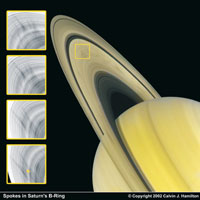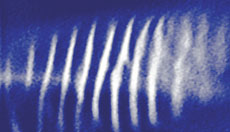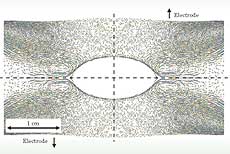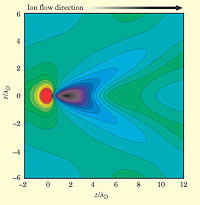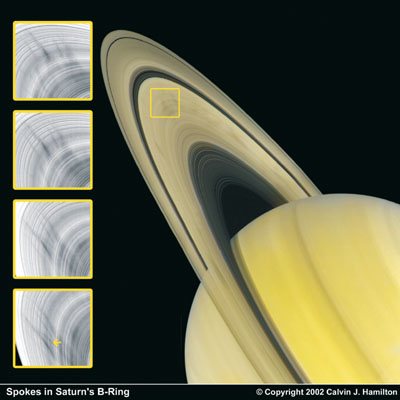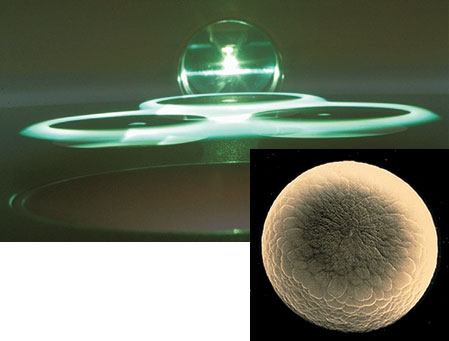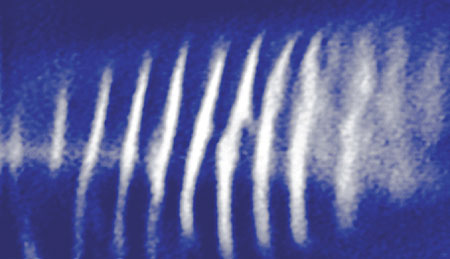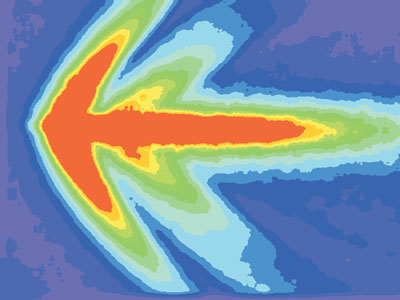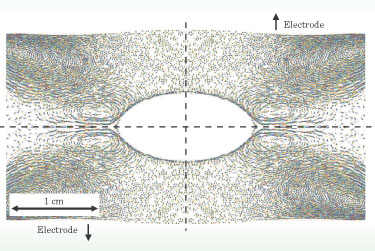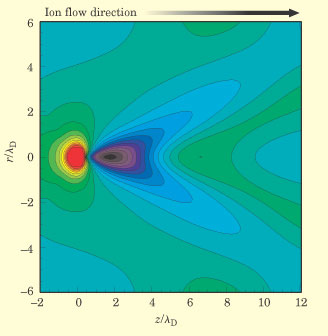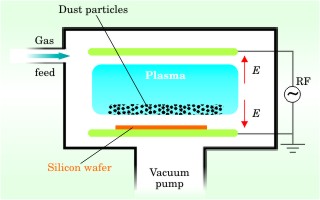|
article from Physics Today, pp. 32 - 38, July 2004 "Dusty plasmas in the Laboratory, Industry and Space" by Robert L. Merlino and John A. Goree |
|||||||||||||||
|
Dusty Plasmas in the Laboratory, Industry, and Space Charged microparticles are an annoyance in the plasmas of fusion energy schemes and semiconductor manufacturing. But in laboratory plasmas and in space, they can be uniquely informative. What do the rings of Saturn have in common with industrial reactors used to manufacture semiconductor microchips? Both are examples of systems containing charged dust particles whose dynamics are controlled by electromagnetic and gravitational forces. More specifically, they are examples of dusty plasmas, defined as partially or fully−ionized gases that contain micron−size particles of electrically charged solid material, either dielectric or conducting. Dusty plasmas are common in astrophysical environments; examples range from the interstellar medium to cometary tails and planetary ring systems. The role of dust in cosmic and laboratory plasmas was discussed early on by Irving Langmuir, Lyman Spitzer, and Hannes Alfvén, three pioneers of plasma physics in the 20th century.1 In a 1924 speech, Langmuir described the "profound effects" he observed in an arc discharge when minute droplets of tungsten vapor were sputtered from the cathode into the plasma. He ascribed the unusual effects to the attachment of electrons to the droplets, causing them to become negatively charged and thus move about under the influence of the electric fields within the discharge. It seems clear that Langmuir was describing the first laboratory observation of a dusty plasma. Spitzer, in 1941, first discussed the processes by which dust particles in the interstellar medium acquire charge. He pointed out that, in addition to photoelectric charging by UV radiation, the dust particles acquire a negative charge due to their immersion in an ionized gas, even though the system's net charge is zero. The dust particles become negatively charged simply because their encounters with the swift electrons are more frequent than with the lumbering ions. Alfvén, in his 1954 monograph On the Origin of the Solar System, considered how the coagulation of dust particles in the solar nebula could have led to planetesimals and subsequently to comets and planets.
Watershed events
This observation—that the spoke material scatters sunlight more effectively in the forward direction—indicated that the material is a fine dust. Perhaps the most interesting aspect of the discovery of the spokes was that they are not stationary structures. Indeed, they develop remarkably fast, with new spokes forming in as little as five minutes. This short dynamical time scale rules out explanations based solely on gravitational effects, indicating that the dust particles are affected by electromagnetic fields. The first proposals that the spokes might consist of charged dust came from Jay Hill and Asoka Mendis at the University of California, San Diego, and independently from Christoph Goertz and Greg Morfill in Germany.3 Goertz and Morfill showed that the charged dust particles were electrostatically levitated about 80 km above the ring plane. They attributed the charging to bursts of plasma generated in localized regions by micrometeoroids that sporadically plunge into boulders in the rings. The insertion of the Cassini spacecraft into orbit around Saturn as this issue of Physics Today goes to press should provide the dusty−plasma community with another boost of exciting results. Cameras aboard Cassini, with higher spatial and temporal resolution than Voyager's, will give us a much−improved view of the formation and evolution of the spokes. The second crucial development in dusty−plasma research, in the late 1980s, expanded the field across disciplinary boundaries. Scientists in the semiconductor industry, rather than astrophysicists, stumbled onto a significant discovery as they searched for the source of particulate contamination of semiconductor wafers. It had been widely believed that particle contamination of silicon substrates occurred mainly during handling of wafers in air. So attention was focused on improving clean−room standards. Nobody thought to check whether the contamination might be happening inside the plasma processing reactors that are used to deposit and etch thin films on the wafers.
Selwyn found that particles actually formed and grew in the gas phase (see box 1), aggregating material from gases that were thought to have been exhausted by the vacuum pump. Then, at the fateful moment when the plasma−generating RF power was switched off, the particles fell and contaminated the wafer. Selwyn's discovery revealed that much of the particle contamination responsible for costly yield losses was happening not just anywhere in the clean rooms, but inside the plasma reactors. Whereas a dusty plasma is something of enduring interest to an astronomer, it was a vexing problem to be avoided by the semiconductor manufacturer. Nevertheless, the two communities suddenly found common ground. Both needed to understand the charging mechanisms and the forces that transport particles from one place to another in a plasma. But not all the progress was visible; secretiveness is often the rule in the semiconductor industry. Successful solutions are often hidden away as proprietary secrets. Some solutions are known to involve plasma−chamber designs that exploit various forces on particles to divert them toward the vacuum pump. There have also been changes in the method of coupling RF energy to the plasma. Rather than relying solely on capacitive coupling, manufacturers now commonly also use inductive coupling to power a plasma−processing reactor. As a result, the electric fields are too weak to levitate particles large enough to cause killer defects on etched wafers. The discovery by the semiconductor industry that RF−powered plasmas can levitate dust particles turned out to be a boon for basic plasma physicists, who study such things as waves and instabilities in ionized gases. Plasma physicists had heard astronomers talk of dusty plasmas in space, and they were eager to study them. The laboratory experimenter, however, has the difficulty that dust particles, unlike plasma ions and electrons, are so massive that they fall rapidly to the bottom of the chamber. Experimenters needed a way to fill a volume of plasma with particles, but gravity seemed sure to thwart them. Then came Selwyn's unexpected discovery. Immediately after the appearance of his 1989 paper, plasma experimenters worldwide realized how they could levitate particles in an RF−generated plasma. Soon, other laboratory methods of filling a plasma volume were developed as well. One can, for example, maintain a dusty plasma by constantly showering particles in from above.
Dust in fusion plasmas
Much of plasma physics is devoted to developing controlled nuclear fusion. Igniting a fusion plasma requires heating deuterium and tritium nuclei to temperatures above 100 million kelvin. At such high temperatures, however, any solid material is vaporized and highly ionized. Therefore nobody expected that dust particles could exist in a fusion plasma, much less that they could be a source of concern.5 It turns out, however, that a magnetically confined fusion plasma is in many ways dominated by the conditions at its edges, where it comes near material surfaces. The outer portions of the plasma typically have temperatures hundreds of times cooler than its center. In this more benign edge plasma, solid particles can survive briefly. Indeed, inspection of the bottoms of magnetic−confinement fusion devices after periods of operation shows the presence of fine dust particles. The particles originate from the solid surfaces exposed to the plasma. Ion bombardment of the lining material (often graphite) liberates atoms that are thought to form dust particles and deposit thin films on other chamber surfaces. As semiconductor engineers know too well, such films easily flake off, creating dust particles that fall down. In a fusion energy reactor, the ion bombardment would be ferocious and long lasting, and the resulting accumulation of dust could be enormous. That poses safety issues because dust particles can retain hazardous quantities of radioactive tritium.
Charging the dust
One calculates the charge on an isolated dust particle in a plasma just as one would calculate the charge on a larger object—for example, an electric probe in a laboratory plasma or a satellite orbiting in the ionospheric plasma. In each case, the object is electrically floating and collects no net current from the plasma. That is,
where Iα represents the possible currents to the particle. The various contributions come from electron and ion currents, secondary electron emission, thermionic emission, and photoelectron emission.6 The individual charging currents depend on Vs, the electrical potential of the grain relative to the plasma. If one assumes that the capacitance of a dust grain of radius a is simply that of a spherical conductor of the same size, one gets Q = 4πε0aVs (2) for the charge Q acquired by the particle. In laboratory dusty plasmas, except under special circumstances, one only needs to consider contributions from electron and ion currents. Because the electrons typically move much faster than the positive ions, an isolated particle immersed in a plasma acquires a negative Vs and thus repels electrons. That lowers the electron current and raises the ion current, thus ensuring that the net current at equilibrium is zero. The electron and ion currents were first derived by Langmuir and Harold Mott−Smith for the case of particles at rest in a dilute Maxwellian plasma.7 Inserting the expressions for those currents in equation 1, one gets Vs = −2.51 kT/e (3) for the surface potential on a particle immersed in a hydrogen plasma, assuming that the temperature T is the same for the electrons and the ions. For a particle of 1−μm radius in a plasma with kT = 3 eV, equations 2 and 3 predict a charge of −8.4 × 10−16 C. That's about 5000 times the electron charge − e. This electron excess is large enough that the statistical spread and temporal fluctuation of charge are quite small in experiments that use plastic microparticles of uniform size and composition. Still, the charge−to−mass ratio of a plasma microparticle is very much smaller than that of an ion. Astrophysical and space plasmas are typically much less dense than laboratory plasmas. And they are subjected to much more UV light. Consequently, the dominant process for charging dust particles in astrophysical plasmas is often photoelectron emission rather than the collection of ambient electrons and ions. Photoelectric charging is apparently responsible for the seemingly bizarre reports of "Moon clouds" by Apollo astronauts in the 1960s and 70s. The report of a "weird glow" on the horizon of the Moon turned out to be the reflection of sunlight from Moon dust particles photoelectrically charged and electrostatically levitated above the lunar surface.8 Experimenters have devised several methods of measuring dust−particle charge. For example, they can measure the charge on an individual grain by letting it fall into a Faraday cup, or they can determine the depletion of electron density on dust or the speed of plasma waves.9 Such methods have verified, among other things, that a particle's charge scales linearly with its diameter and that the charge is diminished by the presence of other particles nearby. In ordinary electron−ion plasmas without dust, the charge on the ions generally remains fixed, even in plasmas containing negative ions. But in a dusty plasma, the charge on a particle does not stay fixed. Because the charge depends on the particle's surface potential relative to the plasma potential, fluctuations in the plasma potential brought about, for example, by plasma waves can cause the dust charge to vary. The charge also varies stochastically, as individual electrons and ions are absorbed at random times. For nanometer particles, this effect can actually switch the charge's sign. Such alternation can enhance the growth rate of particles by collision or coagulation in the dusty plasmas of semiconductor manufacturing reactors and prestellar nebulae.
Plasma waves
The study of waves and instabilities has always been important in plasma physics. The addition of dust particles to a plasma generates many new problems to study.6,9 Theoretically, dust effects have been investigated by extending the usual two−fluid treatment of plasmas with the addition of a third component—the dust. The consequences fall within two categories. First, although dusty plasmas, like most plasmas, are electrically neutral overall, there is an important difference. In a dusty plasma, a large fraction of the negative charge is bound to the particles. This binding is typically observed by noting the precipitous drop in electron current when dust is dispersed into a plasma. The depletion of electrons by absorption on the dust particle affects all kinds of plasma wave modes. For example, ion acoustic waves—the plasma analog of sound waves—propagate at higher velocities and experience far less damping in plasmas containing negatively charged dust particles. Second, the presence of dust particles, with their large inertia and small charge−to−mass ratios, gives rise to new, very low frequency modes (on the order of 1 Hz) that directly involve the dynamics of the particles. One example is the so−called dust acoustic wave, in which adjacent dust fluid elements are coupled by the electric field associated with the wave rather than by collisions, as they would be in a neutral gas.9
Redefining the fourth state
Plasma is often termed "the fourth state of matter" because adding energy to a solid converts it first to a liquid, then to a gas, and finally to a plasma. With a dusty plasma, this progression closes into a circle. It is a plasma that can have the properties of a liquid or a solid. It forces us to reconsider exactly what is meant by the term plasma. Defining plasma as a collection of positive and negative charges that are not atomically bound to one another, we encounter two possibilities. Most commonly, the charges have abundant kinetic energy and fly easily past their neighbors, much like molecules in a gas. That's termed a weakly coupled plasma. The obverse is the less common strongly coupled plasma, which has charged particles whose kinetic energy is much less than the electrostatic potential energy between neighbors. Previously, the best−known strongly coupled plasmas included the interiors of stars and laser−cooled ion aggregates. In stellar interiors, the ratio γ of electrostatic to kinetic energy is large because of high density and small interparticle spacing. In laser cooling, γ is large because the ion temperature is so low. Now we have another way of making a strongly coupled plasma. In 1986, Hiroyuki Ikezi predicted10 that dust particles in plasma could acquire enough charge to produce a large γ. As soon as Selwyn had discovered a means of levitating dust particles, experimenters began making dusty plasmas that were indeed strongly coupled. By their mutual Coulomb repulsion, the suspended dust particles can organize themselves into spectacular crystal−like arrays (see box 2).11 These arrays are reminiscent of the "Wigner crystals" whose existence in the electron seas of metals at sufficiently low temperature was predicted by Eugene Wigner in the 1930s. The hexagonal monolayer array of 8−μm−diameter plastic microparticles shown in box 2 is called a Coulomb crystal. Box 2 also shows an example of the diagnostic techniques that have been developed not only to image static patterns of dust particles in a plasma but also to permit a complete mapping of their individual motions in dynamical situations.12 Nothing like that can be done for the ions of ordinary plasmas, for which one can only measure statistical distributions. The ability to image dusty plasmas at the particle level lets researchers study the melting phase transition, phonons, and other condensed matter phenomena with unprecedented directness.13 One manifestation of phonons that is uncommon in molecular solids is the so−called Mach cone, a V−shaped wake created by a moving supersonic disturbance. In a laboratory dusty plasma, Mach cones are made by applying force to the particles by means of laser light. Using a setup like that shown in box 2, one of us (Goree) and coworkers swept an argon laser beam across a monolayer suspension of plastic microparticles.12 The laser sweep caused a moving disturbance. The microparticles were illuminated for imaging by light from a much weaker helium−neon laser.
Ove Havnes and coworkers at the Auroral Observatory in Tromso, Norway have suggested that Mach cones might be found in planetary rings, produced by big boulders plowing through fields of charged dust.14 While the boulders keep pace with the Kepler orbital velocity, they argue, the Lorentz force of the planet's magnetic field could modify the orbital motion of the charged dust. A remote search for Mach cones in Saturn's rings with viewing instruments aboard the Cassini spacecraft could yield information about the dusty plasma conditions in regions through which Cassini would not survive direct transit. The remote imaging is possible because the dust particles scatter sunlight. As the dust concentration is compressed and then rarefied in the waves that compose the wakes, it will appear brighter and then dimmer. Measuring a Mach cone's opening angle would yield information about dust parameters such as the particle size.
Microgravity experiments
The weightlessness provided by space vehicles in orbital free fall is ideal for experiments on dusty plasmas. On the ground, experimenters must contend with gravity. The prospect of a weightless laboratory environment was so attractive that the first physics experiment on the International Space Station (ISS), begun in February 2001, was a dusty−plasma experiment.15
In the absence of gravity, one has the opportunity to see both liquid− and solidlike phenomena as other forces emerge to affect the dynamics of the dust. Charged dust particles in plasma are affected by their mutual electrostatic interaction and by interaction with gas molecules and ions. Thermal gradients produce thermophoretic forces. Ion drag, which can be the dominant force under weightless conditions, is thought to have caused the void seen in figure 5 by pushing dust particles out of the center of the plasma chamber's RF discharge.
Noctilucent clouds
At an altitude of about 85 km, well below the orbiting ISS, there's a fascinating example of a naturally occurring dusty plasma: the so−called noctilucent clouds. These "night−shining" clouds, seen at high latitudes in the early summer months, are composed of ice crystals. The clouds form in the polar mesosphere, where temperatures can get down to 100 K. At this lower reach of the ionosphere, free electrons can attach to the ice particles (typically 50 nm across) to form a dusty plasma. Noctilucent clouds are perhaps related to observations of unexpectedly strong radar echoes from the polar regions.16 The enormous backscatter cross section observed in the summer mesosphere came as quite a surprise to radar scientists. Models have been developed to relate charged dust to localized ionization and electron depletions that would result in upper−atmosphere inhomogeneities strong enough to account for the abnormal radar echoes. But there is, as yet, no consensus. Curiously, there has been an increase in the observed frequency of the noctilucent clouds over the past 30 years. The increase may be caused by rocket engine exhaust, which is mostly water vapor. Water vapor released at very high altitudes tends to collect near the poles. Ironically, work on dusty plasmas has been carried out over the years by groups with entirely opposite motivations. Initially, industrial scientists and engineers worked feverishly to eliminate dust from plasma−processing devices. Meanwhile, physicists doing basic plasma research were devising schemes to get dust into plasmas so that they could study its effects. As is often the case, researchers in these varied disciplines barely knew of each other's existence, rarely talked with each other or attended the same meetings, and seldom published in the same journals. Eventually, however, they were brought together by the realization that they were investigating the same basic phenomena. Nowadays they share in plasma−source development and diagnostic techniques. Much progress has also been made in recent years in the theoretical and numerical analysis of dusty plasmas. Dusty plasmas challenge modelers for a number of reasons. For example, the dust motion occurs on a much longer time scale than that of the ions and electrons, and the dust might have a distribution of particle sizes. The charge on the particle is not fixed. Futhermore, the dust particles can be strongly coupled to each other via short−range forces. That's entirely different from dust−free plasmas, whose constituents interact through relatively weak, long−range forces.
The imposing intellectual range of physics issues touched on by the study of dusty plasmas extends beyond plasma physics to include, for example, the solid−liquid melting transition and vortex flows in fluids. And size range of dusty−plasma applications extends from microgrooves in semiconductor devices to the magisterial rings of Saturn.
1. I. Langmuir, C. G. Found, A. F. Dittmer, Science
60, 392 (1924); H. Alfvén, On the Origin of the
Solar System, Clarendon Press, Oxford, UK (1954); L. Spitzer
Jr, Physical Processes in the Interstellar Medium, Wiley,
New York (1978).
2. B. A. Smith et al., Science 215,
504 (1982) [INSPEC].
3. C. J. Hill, D. A. Mendis, Moon and Planets
23, 53 (1980) [INSPEC];
C. K. Goertz, G. Morfill, Icarus 53,
219 (1983) [INSPEC];
C. K. Goertz, Rev. Geophys. 27, 271 (1989) [INSPEC];
M. Horanyi, Annu. Rev.
Astron. Astrophys. 34, 383 (1996) [CAS].
4. G. S. Selwyn, J. Singh, R. S. Bennett, J. Vac.
Sci. Technol. A7, 2758 (1989).
5. J. Winter, Phys. Plasmas 7,
3862 (2000) [INSPEC];
K. Narihara et al., Nucl. Fusion
37, 1177 (1997) [INSPEC];
S. I. Krasheninnikov, Y. Tomita, R. D. Smirnov, K. K. Janev, Phys. Plasmas 11,
3141 (2004) [SPIN].
6. P. K. Shukla, A. A. Mamun, Introduction to
Dusty Plasma Physics, Institute of Physics, Bristol, UK (2002).
7. I. Langmuir, H. Mott−Smith, Phys. Rev. 28,
727 (1926) .
8. See http://www.space.com/scienceastronomy/top_10_weird.
html.
9. B. Walch, M. Horanyi, S. Robertson, Phys. Rev. Lett.
75, 838 (1995) [INSPEC];
R. L. Merlino, A. Barkan, C. Thompson, N. D'Angelo, Phys. Plasmas 5,
1590 (1998) [INSPEC];
A. Piel, A. Melzer, Plasma Phys.
Controlled Fusion 44, R1 (2002) [INSPEC].
10. H. Ikezi, Phys. Fluids 29,
1764 (1986) [INSPEC].
11. H. Thomas, G. E. Morfill, V. Demmel, J. Goree,
B. Feuerbacher, D. Möhlmann, Phys. Rev. Lett.
73, 652 (1994) [INSPEC];
J. H. Chu, I. Lin, Phys. Rev. Lett.
72, 4009 (1994) [INSPEC];
Y. Hayashi, K. Tachibana, Jpn. J. Appl. Phys.
33, L804 (1994) [INSPEC].
12. A. Melzer, S. Nunomura, D. Samsonov, Z. W. Ma,
J. Goree, Phys.
Rev. E 62, 4162 (2000) [INSPEC].
13. A. Melzer, A. Homann, A. Piel, Phys. Rev. E
53, 2757 (1996) [INSPEC];
H. M. Thomas, G. Morfill, J. Vac. Sci. Technol.
14, 501 (1996) [SPIN].
14. O. Havnes et al., J. Geophys. Res. 100,
1731 (1995) [INSPEC];
O. Havnes et al., J. Vac. Sci. Technol. A 14, 525
(1996).
15. A. Nefedov et al., New J. Phys. 5,
33.1 (2003).
16. J. Y. N. Cho, M. C. Kelley, Rev. Geophys. 31,
243 (1993) [INSPEC].
17. M. Lampe, G. Joyce, G. Ganguli, Phys. Plasmas 7,
3851 (2000) [INSPEC].
18. G. S. Selwyn, Plasma Sources
Sci. Technol. 3, 340 (1994) [INSPEC].
Figure 1. Dynamic spokes in Saturn's B ring, the wide bright ring just inside the prominent dark Cassini ring. The square fields at left are successive detailed images of the same orbiting physical region (yellow square), taken at roughly 10−minute intervals by Voyager 2 in 1981. The observed pattern of nearly radial "spokes," appearing dark against a bright background as the spacecraft approaches from the Sun side, changes quite rapidly. New spokes form in as little as five minutes, which suggests that the fine dust particles that compose them are affected by electromagnetic fields. (Courtesy Calvin J. Hamilton.)
Figure 2. Rings of dust particles encircling silicon wafers in a plasma processing device. In an accidental 1989 discovery, laser light was shone into a plasma used to etch Si wafers so that the expected weak optical fluorescence would monitor concentrations of reactive gas. Instead, the fluorescence was overwhelmed by scattering of the incident light off unanticipated clouds of micron−sized particles electrically suspended in the plasma above the wafers.4 Although great pains had been taken to minimize dust contamination of the clean room, it was discovered that the particles actually formed and grew in the plasma. When the RF power that generates the plasma is turned off, the particles fall onto the wafer, contaminating it. (Inset) An electron−microscope image of a 20−μm−diameter particle from such a dust cloud. (Adapted from ref. 18.)
Figure 3. A dust acoustic wave propagating in a plasma shows up in a video image of light scattered by dust clouds in the plasma. The bright bands are compression wavefronts. Ordinary plasma waves in dustless plasmas cannot be visually imaged in this way. The wave is essentially a sound wave in the charged dust component of the plasma. Because the wave propagation involves the dynamics of the heavy dust particles with small charge−to−mass ratios, it's very slow (a few centimeters per second) and its frequency is only on the order of a hertz. By contrast, ion−acoustic waves in the plasma travel at kilometers per second. (Adapted from A. Barkan et al., Phys. Plasmas 2, 3563 (1995).)
Figure 4. A Mach cone formed in a laboratory dusty plasma by suddenly pushing plastic microparticles in a suspended monolayer toward the left by means of an intense, movable laser beam in a setup like that depicted in box 2. The disturbed particles are illuminated by another, less intense laser and imaged with a video camera. False colors indicate resulting microparticle speeds in different regions of the monolayer. Red is fastest, blue slowest. The clearly observed Mach cone is a superposition of supersonic wakes generated by particles moving faster than the slow acoustic speed of the plasma's dust component, in which Coulomb repulsion, rather than collision, is the mechanism of acoustic propagation. The red region is about 2 cm long, and the displayed field comprises about 104 microparticles. (Adapted from ref. 12.)
Figure 5. A weightless dusty plasma in the Nefedov Plasma Crystal Experiment aboard the International Space Station, an RF−powered plasma discharge chamber device similar to that shown in box 2. The single−frame video image shows that, in the weightless space station environment, the micron−size dust particles fill the entire three−dimensional plasma volume except for a well−defined central void from which dust particles are expelled by ions retreating from a region of positive plasma potential. The dust distribution exhibits fluid−like vortices as well as stable crystal−like domains. (Adapted from ref. 15.)
Figure 6. Numerically calculated equipotential contours near a charged dust grain in a plasma in which the ions are flowing past the grain from left to right along the z−axis of cylindrical coordinates.17 The grain's surface potential is negative. The coordinates are in units of the characteristic Debye shielding length λD in the plasma. Large negative potential is shown red; large positive is purple. Near the origin, where the grain is centered, the potential is large and negative. But it drops off rapidly due to the shielding by the plasma. A wake forms in the downstream direction, producing a deep positive well. Thus ions are focused onto the region immediately downstream of the grain. This wake accounts for the experimental observation that dust particles tend to align directly behind each other along the direction of ion streaming. (Courtesy of Glenn Joyce.)
Box 1. Unwanted Particles in Silicon Processors
Box 2. Formation of a Coulomb Crystal In a number of experiments, one of us (Goree) and coworkers formed plasmas by applying RF power to the 23−cm−diameter electrode at the bottom of a parallel−plate plasma chamber like that shown in box 1. From a "salt shaker" above the electrode, we sprinkled 8−μm−diameter plastic spheres into the plasma. The particles acquire negative charge by collecting electrons from the plasma. Thus they become levitated as a horizontal monolayer several millimeters above the lower electrode. The suspended microparticles organize themselves by mutual electrostatic repulsion into a planar triangular Coulomb lattice with hexagonal symmetry.11 The pattern is illuminated by a sheet of helium−neon laser light and imaged by a video camera. For more dynamical studies, we can disturb the microparticles with an intense, steerable argon laser beam (see figure 4 and ref. 12) .
|
